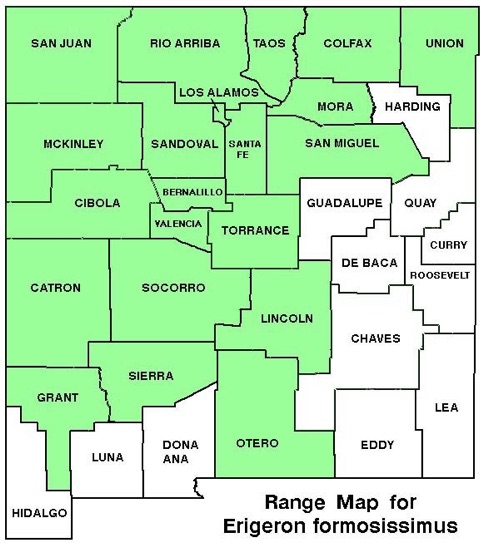WILDFLOWERS OF NEW MEXICO

Colonies of basal rosettes from spreading roots produce clusters of 4–16-inch tall, hairy to hairless flower stems with multiple branches. Each terminal flower head is densely packed with lavender to white ray flowers surrounding a yellow disk. The species name formosissimus means “most beautiful” in Latin. Note the stem leaves clasp the stem and get progressively smaller up the stem.
FLOWERS: July–October. Lavender to white, 75–150 petal-like ray flowers crowded in layered rows around a yellow disk 3/8–3/4-inch (10–20 mm) wide. Ray florets are 3/8–5/8 inch (8–15 mm) long, 1 mm wide. The phyllaries beneath the floral head are about equal length, greenish, slender, pointed, variously hairy.
LEAVES: Basal and alternate on stem. Basal leaves rounded to spatula-shaped, to 6-inches (150 mm) long including stem (petiole), margins entire, surfaces and edges with few hairs. Stem leaves clasp stem, blades narrow, lance-shaped to spatula-shaped, gradually reduced upward; surfaces hairless or with rough, shaggy hairs; margins lined with ciliate hairs.
HABITAT: Sandy, gravelly soils, meadows, open areas, common; ponderosa pine, spruce-fir forests.
ELEVATION: 7,800–11,000 feet.
RANGE: AZ, CO, MT, NM, SD, UT, WY.
SIMILAR SPECIES: Two varieties, as well as intermediates, in NM with a great difference in amount of hair on the leaves: E. formosissimus var. viscidus has few hairs on upper leaves; E. formosissimus var. formosissimus has densely hairy upper leaves.
NM COUNTIES: Statewide in mid- to high-elevation habitats: Bernalillo, Catron, Cibola, Colfax, Grant, Lincoln, Los Alamos, McKinley, Mora, Otero, Rio Arriba, San Juan, San Miguel, Sandoval, Santa Fe, Sierra, Socorro, Taos, Torrance, Union, Valencia.

BEAUTIFUL FLEABANE
ERIGERON FORMOSISSIMUS
Aster Family, Asteraceae
Perennial herb

THE CONTENTS OF THIS WEBSITE ARE COPYRIGHTED AND CANNOT BE USED
WITHOUT PERMISSION OF GEORGE OXFORD MILLER





Basal leaves lance-shaped with long stems (petiole) (lower arrow); stem leaves reduced in size upward and clasping the stem (upper arrow).

Upper leaves clasp stem and have hairy margins (left); phyllaries with shaggy hairs (right).





EMAIL ME